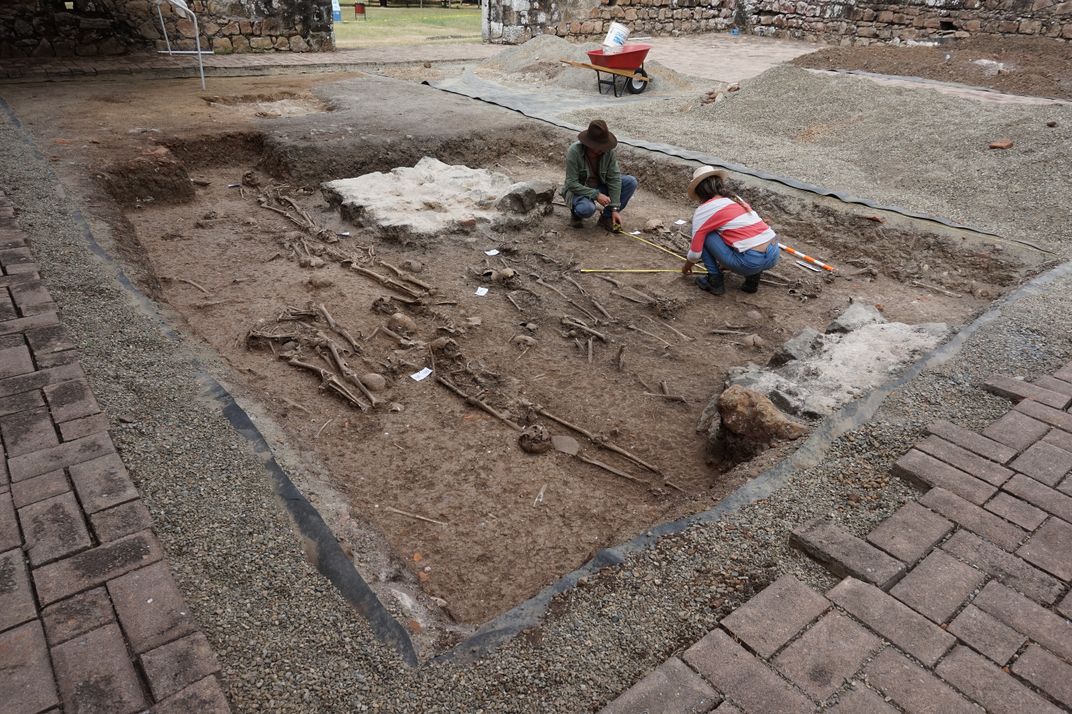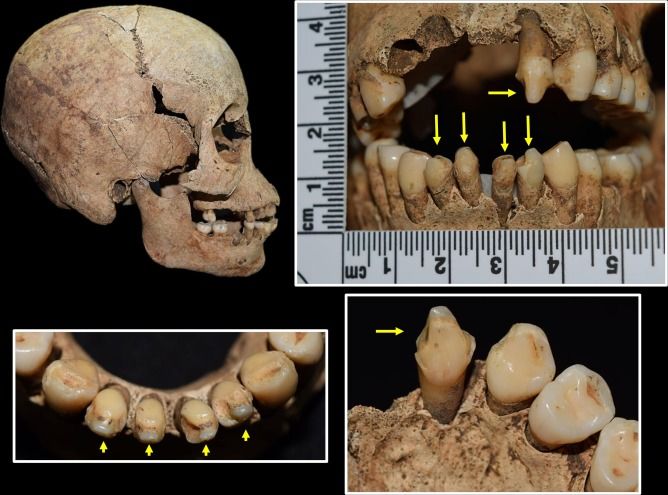SMITHSONIAN TROPICAL RESEARCH INSTITUTE
An ‘oral’ history: Archaeologists search for the origin of dental modification in Panama
A new study asks when and how the Ngäbe indigenous group began to practice dental modification
:focal(3000x1995:3001x1996)/https://tf-cmsv2-smithsonianmag-media.s3.amazonaws.com/blogging/featured/DentalMod1.JPG)
Most modern cultures practice some form of dental modification, for health, therapeutic or aesthetic purposes: whether it’s filling a cavity, removing wisdom teeth, adding veneers or braces or whitening teeth.
Recently, teenagers posted videos proudly showing their drastically filed teeth on the social media app, TikTok, prompting dentists to respond by pointing out the irreversible damage caused by removing tooth enamel.
In Panama, while each of the seven indigenous groups expresses their own cultural identity via dress, makeup and jewelry, and even by means of more permanent body modifications, such as tattoos and piercings, the Ngäbe, a group of about 260 thousand people living mostly in the mountains of Western Panama, also practice dental modification.
In a recent publication in the Journal of Anthropological Archaeology, titled “Intentional dental modification in Panamá: New support for a late introduction of African origin,” researchers Nicole Smith-Guzmán, Javier Rivera-Sandoval, Corina Knipper and Ginés Alberto Sánchez Arias present bioarcheological and isotope data indicating that the Ngäbe practice may have been introduced by African slaves in early colonial times.
Dental modification is the practice of changing the shape of teeth by filing, chipping, drilling, extracting and other intentionally applied techniques. This practice is tens of thousands of years old and could be found in all parts of the globe. In the ancient Maya civilization, members of the upper class had holes drilled into their teeth for precious gemstone inlays, or cut their teeth into different shapes, to beautify and demonstrate status; in Europe, the Vikings would file grooves and designs into the front part of their teeth, possibly to mark achievements or to scare their enemies; in Japan, women would practice Ohaguro or teeth blackening, using vegetable tannins and a ferric acetate solution to dye the teeth black (which actually protected the teeth from decay), and it was considered a sign of maturity and beauty.
“The oldest form of intentional dental modification goes back to at least 13,000 years ago in Northwest Africa, where nomadic groups practiced dental ablation, the intentional extraction of teeth from the mouth, perhaps motivated by a need to feed individuals experiencing the lockjaw effects of tetanus infection,” explains Nicole Smith-Guzmán, bioarcheologist and post-doctoral fellow at the Smithsonian Tropical Research Institute (STRI).
The reasons for this practice and its significance vary from culture to culture and through time; and can even be different within the same culture.
“Intentional modifications might have originated based on a medical need, but there is later evidence that these cultures continued the practice for aesthetic purposes,” Smith-Guzmán says. “Having a tooth missing became a desired look even if it had no practical reason. Other cultures may have practiced it as a means of expressing cultural identity.”

For this investigation, the researchers had the chance to participate in the excavation taking place in Panama Viejo as part of the multidisciplinary project Artery of Empire, headed by historian Bethany Aram of the Universidad Pablo de Olavide in Seville, Spain, and funded by the European Research Council (ERC); ArtEmpire was a project to take a more in-depth look at the early history of the Spanish colonization of Panama.
In addition to teeth excavated in the Artery of Empire project, the researchers compared teeth from a total of 14 archaeological sites; the sites within the metropolitan area of Panama City contained mostly individuals from the early colonial period (post-European contact), and therefore a more diverse population, while the individuals recovered from sites outside the city were pre-colonial (pre-contact). A total of 598 individuals were excavated; 232 pre-contact, and 366 post-contact.
Specialist Corina Knipper examined the strontium isotope compositions of tooth enamel, which helps identify where individuals are from. Isotopes, from the Greek isos ‘equal’ and topos ‘place’, are atoms of the same element that have similar chemical properties but not the same nuclear properties; therefore, their specific value indicates the chemical composition and age of minerals and other geological objects.
Knipper’s analysis painted a more complete picture of the geographical origin and diet of the early colonial individuals with modified teeth, while cultural geographer Ginés Sánchez provided insights into the meaning of the current practice by the indigenous communities in Western Panama.

None of the pre-contact samples show dental modification. But an examination of the teeth and the isotope analysis of post-contact samples found the earliest known example of dental modification in Panama in several individuals of African origin or ancestry. These results provide some evidence that the custom might have been introduced to Panama by African slaves who escaped Spanish towns and settled in other parts of the isthmus.
“This is a challenging hypothesis to prove because we don’t have any documentary evidence of the specific practice of dental modification in Panama until the 19th century,” Smith-Guzmán explains. “From the Panama Viejo findings, we know now that enslaved people with modified teeth were brought to Panama from Africa, but we still don’t have evidence that the practice was continued by these individuals after they arrived on the Isthmus.”
She hopes that they can obtain more evidence if they locate and do archaeological exploration of a colonial period burial ground associated with a community of cimarrones, the name given to the enslaved Africans who escaped their Spanish masters and formed isolated, autonomous villages.
Another idea, yet to be explored, is the possible exchange with indigenous groups from northwestern Costa Rica, where there is evidence of pre-Columbian dental modification, perhaps through the Bocas del Toro region to the Ngäbe.
“Finally, oral histories from Ngäbe communities should be more fully pursued with our cultural anthropologist and geographer colleagues,” Smith-Guzmán says. “The information in this article is only barely scratching the surface and will hopefully continue to shed light on the modern cultural practice and its meaning.”
“We are interested in exploring other practices associated with dental modification, related to cultural and occupational practices, which have been documented in pre-Hispanic populations as well as in colonial ones,” explains Javier Rivera-Sandoval, bioarchaeologist from Universidad del Norte in Colombia. “This way we can evaluate the impact that these modifications had in the oral health of these groups and the socio-cultural context in which they were done.”
Smith-Guzman notes that even in ancient times, dental modification practitioners were highly skilled.
“They knew what they were doing and that these practices were often supported by some sort of benefit to the individual,” she remarks. “In fact, protection against dental decay or disease is among the earliest recorded motivations for the practice in Ngäbe communities during the 19th century.”

This study points out that dental filing is not as ubiquitous as other elements that point to Ngäbe authenticity, but rather more of an individual form of self-expression, and that the custom is more restricted to groups who live in more secluded mountainous regions of the Ngäbe-Buglé comarca. Still, according to the investigation, the Ngäbe are the only indigenous group in Central America who currently modify the shape of their teeth, and thus is has become an embodiment of Ngäbe identity among those who practice it.
“I think this continued practice certainly speaks to the resilience of the indigenous people of Panama,” Smith-Guzmán states. “Although we don’t know exactly how long these groups have been modifying their teeth, we know it has been continuous for at least the past 200 years, and it’s just one example of the multitude of ways in which the Ngäbe and other indigenous groups in Panama have actively resisted the effects of Spanish conquest and settlement of the isthmus to maintain cultural cohesion in terms of their traditions, languages, rituals and crafts.”
Nicole E. Smith-Guzmán, Javier Rivera-Sandoval, Corina Knipper, Ginés Alberto Sánchez Arias, 2020. Intentional dental modification in Panamá: New support for a late introduction of African origin. Journal of Anthropological Archaeology, https://doi.org/10.1016/j.jaa.2020.101226
Artery of Empire, «ArtEmpire», ERC CoG 643565 [PI: Bethany Aram], financed by the European Research Council, https://www.upo.es/investigacion/artempire/

